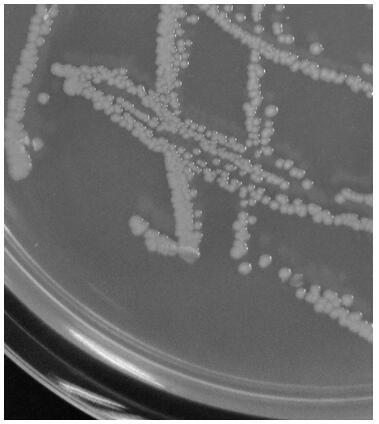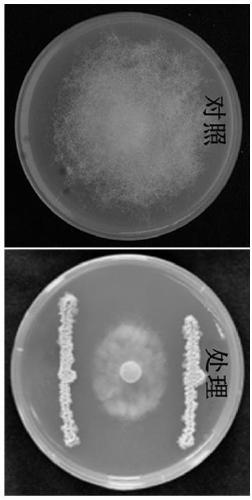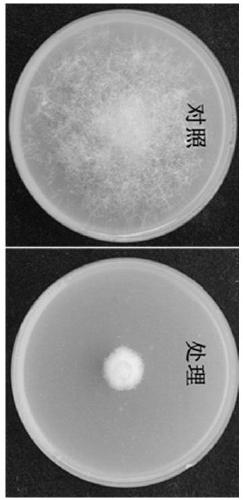Bacillus amyloliquefaciens and application thereof in control of potato late blight
A technology for potato late blight and amylolytic spores, applied in the fields of application, bacteria, and fungicides, can solve problems such as unsatisfactory chemical control effects and environmental pollution, and achieve good development and application prospects, broad antibacterial spectrum, and strong inhibitory effect Effect
- Summary
- Abstract
- Description
- Claims
- Application Information
AI Technical Summary
Problems solved by technology
Method used
Image
Examples
Embodiment 1
[0024] Example 1 Isolation and identification of antagonistic bacteria
[0025] l. Soil sample collection and strain isolation
[0026] Gently shovel off the topsoil around the rhizosphere of healthy tomato plants, use a soil sampler to take a soil sample at a depth of 5-10 cm, pour it into a sterilized ziplock bag, make real-time records, and take it back to the laboratory for isolation . Randomly weigh 10 g of each soil and place it in a 250 mL Erlenmeyer flask filled with 90 mL of sterile water and a small amount of glass beads. After the bottle mouth is fixed with a sealing film, it is shaken on a shaker at 200 r / min for 30 min, and after standing for 5 min, , draw 1 ml of the soil sample suspension with a pipette gun, add it into a test tube filled with 9 ml of sterile water and mix well, that is 10 -2 The same method was used to prepare 10 times soil sample dilution solution in turn. -3 、10 -4 、10 -5 、10 -6 times soil sample dilution. Take 100 ul of the prepared...
Embodiment 2
[0035] Example two: Inhibitory effect of bacterial strain GZ5 live body on the mycelial growth of potato late blight pathogen
[0036] Take the spare rye medium and LB medium, melt them in the microwave, mix them in equal proportions and pour them onto plates. Inoculate the mycelium block of P. infestans (D=7 mm) in the center of the mixed culture dish of rye medium and LB in equal proportions, and dip the GZ5 on the plate with an inoculation loop at a distance of 2.5 cm from the opposite sides of the mycelium block. Bacterial liquid was streaked, and only the mycelial block of P. infestans of the same size was connected as a control, repeated 3 times, placed in a constant temperature incubator at 20 ℃ for cultivation, and the antibacterial rate was counted. The result is as figure 2 As shown, when the control P. infestans covered the petri dish, the growth of P. amyloliquefaciens in the test group showed the phenomenon of evading Bacillus amyloliquefaciens GZ5, and the bact...
Embodiment 3
[0037] Embodiment three: the inhibitory action of bacterial strain GZ5 fermented liquid to the mycelia growth of P. infestans
[0038] Add 2 mL of the fermentation broth of strain GZ5 to 20 mL of melted rye medium cooled to about 45 ℃, mix and invert the plate to make an antibacterial plate of the fermentation liquid of strain GZ5, and inoculate potato latex with a diameter of 7 mm in the center of the plate. Phytophthora mycelium block. Add 2 mL of LB liquid medium to 20 mL of melted rye medium cooled to about 45 °C, mix and pour the plate, and inoculate the mycelial block of P. infestans with a diameter of 7 mm in the center of the plate as a control. Repeat 3 times, culture in a 20°C incubator, measure the growth diameter of the colony by the cross method, and calculate the inhibition rate. The result is as image 3 The results showed that the fermentation broth of strain GZ5 could significantly inhibit the mycelial growth of P. infestans. After 14 days of cultivation, th...
PUM
 Login to View More
Login to View More Abstract
Description
Claims
Application Information
 Login to View More
Login to View More - R&D
- Intellectual Property
- Life Sciences
- Materials
- Tech Scout
- Unparalleled Data Quality
- Higher Quality Content
- 60% Fewer Hallucinations
Browse by: Latest US Patents, China's latest patents, Technical Efficacy Thesaurus, Application Domain, Technology Topic, Popular Technical Reports.
© 2025 PatSnap. All rights reserved.Legal|Privacy policy|Modern Slavery Act Transparency Statement|Sitemap|About US| Contact US: help@patsnap.com



